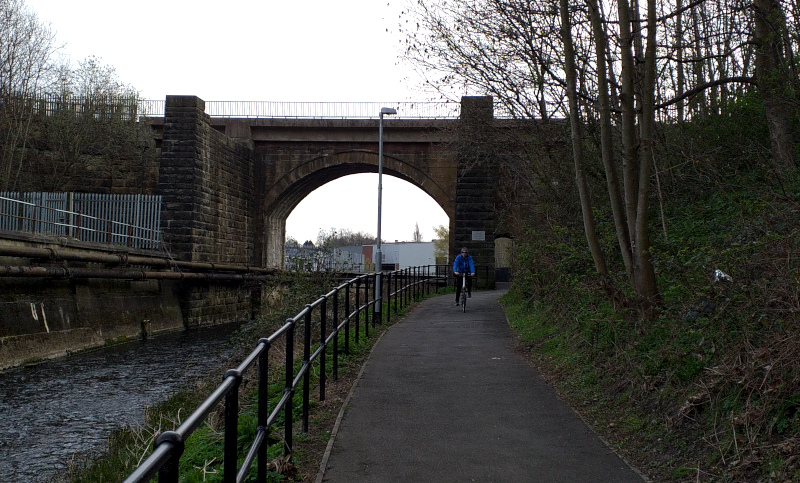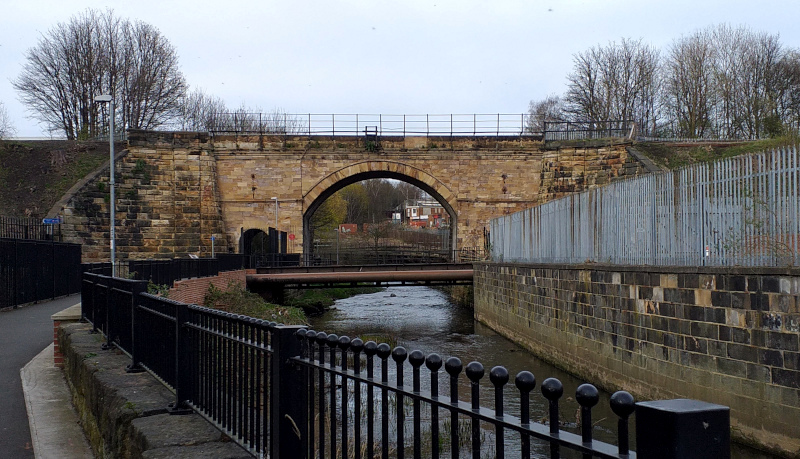The Skerne Railway Bridge at Darlington is the oldest railway bridge in the world that’s still being used. It was designed in 1824 and, to this day, from early morning until late evening, several trains an hour pass over the bridge travelling between Bishop Auckland and Saltburn-by-the-Sea.
If you arrive at Darlington via train and want to visit the Skerne Railway Bridge, it’s best to get off the train at North Road Station instead of the main train station, near the centre of town.You’ll have less distance to walk.
North Road station is located next door to Darlington Railway Museum [WEBSITE], which reopened following refurbishment in April 2008 under the new name “Head of Steam.” If you are interested in Railway history, it’s a place you may want to visit as well.
Regardless of if you visit the museum or not, if you get off the train at North Road Station, the Bridge over the River Skerne is only an 8-minute walk. [MAP]
Getting off at the main station would add a further 10-12 minutes to your journey.
But should you visit the oldest operational railway bridge in the world? Is it worth making the journey and what can you expect? If these questions are running through your mind, this article provides information that can help you decide what to do.

About The Skerne Bridge (A Short History Lesson)
As you may be aware, the Stockton and Darlington Railway was the first railway in the world to carry freight and passengers using engines powered by steam. The first Locomotive to make the journey was Locomotion 1, built in 1825 by George Stevenson.
However, railway tracks need to be level. Train wheels don’t have the traction to handle hills. This presented a problem for the early pioneer of steam because the rail tracks had to pass over the River Skerne at an area where it cuts through a deep ravine. To kame the journey between Darlington and Stockton possible it was necessary to build a bridge over the Skerne.
The railway directors originally asked George Stephenson to build a bridge made from iron and stone. However, when a similar bridge was washed away in West Auckland, it forced the railway directors to rethink their plans.
The rising cost of steel also made a metal bridge across the Skerne a less financially viable option.
Stephenson sought advice from the architect Ignatius Bonomi, who was the Surveyor of Bridges in the County Durham area. Often known as the first railway architect, Bonomi decided the best thing to do was fill the sides of the ravine with rubble and then build a three-arch stone bridge over the Skerne. The two smaller arches on each side of the river were intended for pedestrian use.
The foundation stone was laid on July 6, 1824, and the bridge was completed during the early months of the following year so it was built pretty fast.
Locomotion 1 made its first journey on September 27, 1825, passing over the Skerne Bridge and securing its place in history while hauling its passengers in a special carriage called “Experiment.”
In 1990, the Bank of England paid homage to these early days of steam by printing pictures of George Stevenson, Locomotion 1, and the Skerne Bridge on the back of its new £5 notes.

However, the bridge had some problems during its early years. Bonomi had plenty of experience designing bridges but all of his earlier bridges only needed to be strong enough to carry horses and people. By 1828, the railway lines crossing the River Skerne were carrying more than 52,000 tons of coal a year and over 40,000 passengers.
The bridge was having a harder life than anyone had expected and the embankments on both sides of the river were becoming seriously damaged.
Faced with a potentially dangerous dilemma, the directors of the Stockton and Darlington Railway sought the help of the respected stonemason John Falcus Carter.
Carter already had ties with the railway company because he designed the world’s first railway-themed pubs, including Locomotion One at Heighington Station.
In 1829, Carter fortified the existing structure by adding the curved walls you can see at the side of the Skerne Bridge when you visit it today. These were not part of the original structure but Carter did his job well and the bridge continues to stand the test of time.
However, although it’s now easy to go and take a look at the oldest railway bridge that’s still in use, things were not always so simple in the past. For many years the area around the bridge was fenced off.
In the late 1800s, the gasworks on John Street expanded and large gas pipes were placed over the river. These spoiled the view of the bridge but that was not such a big issue because pedestrian access to the bridge was cut off when the gasworks fenced off the area. The area below the Skerne Bridge remained inaccessible for most of the 20th century.
Even when the John Street gasworks closed down, the area around the bridge was not an attractive place to visit. It was a favourite haunt for vandals, drug users, and litterbugs. Things are different now.

In 2015, Darlington Borough Council began a restoration project in readiness for the 200th anniversary of Stockton and Darlington Railway. Since then, the council has made improvements to the cycle path beside the river and made it easy to access the Skerne Railway Bridge, which is now a scheduled monument. They have also taken away parts of a concrete wall that made the Skerne look similar to a canal.
On Wednesday, September 27, 2017, the Lord Lieutenant, Sue Snowdon officially unveiled the new Skerne Bridge and John Street heritage area.
The ceremony had two unveilings instead of one. As well as officially opening the new, green metal arch that marks the entrance to the new John Street cycle path, she also unveiled a newly-acquired Transport Trust Heritage Plaque.
The new metal arch was made in nearby Newton Aycliffe by Aycliffe Fabrications and, although the arch is situated a little way down an alleyway, it’s striking enough to catch the eye of anyone travelling along Darlington North Road (A167).
Transport Trust Heritage Plaques or “Red Wheels” are awarded to sites that have significant importance to Britain’s transport history.
What to Expect If You Visit Skerne Bridge

If you have a burning interest in the trains and/or Britain’s railway heritage, you will probably find Skerne Bridge is an interesting place to visit and there’s a board on the southern side of the bridge that provides a little information about the site.
If you not a railway buff you may still enjoy a brief visit but, despite the renovations, it’s hardly an awe-inspiring location. The Skerne Bridge an interesting thing to see if you are already in Darlington for another reason but doesn’t really warrant a special visit.
Although the path/cycleway beside the river is nice and clean and is well lit at night, the most interesting thing about the Skerne Bridge is its historical importance. When you look at it, all you will see is a bridge made of stone that has discoloured and gone black in places through the years.
You will also notice lots of big, black, rusty pipes that pass over the river and then run underneath it along the wall. It’s not a pretty sight.
Having said that, if you follow the path heading North, it will take you under the Five Arches Railway Bridge to the Rockwell Nature Reserve. If you explore it, you may encounter some interesting wildlife including kingfishers and otters.
– – – – –
– – –
– – –
– – – – –
